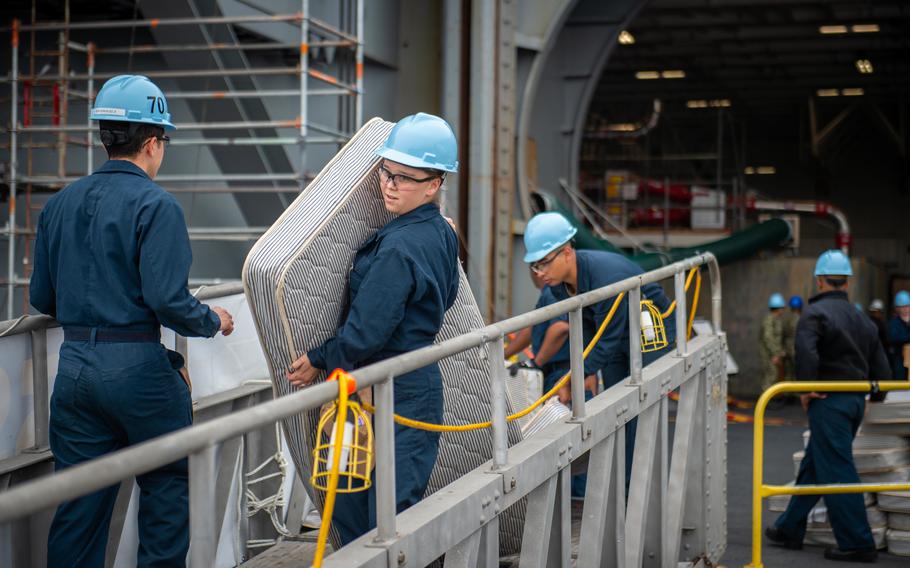
Seaman Alli Rambo carries a mattress off the USS Carl Vinson in San Diego on June 2, 2022. Sailors aboard Navy ships are still sleeping on uncomfortable mattresses, and that is one of the factors hampering the service's efforts to reduce fatigue in the fleet, the Government Accountability Office said in a new report. (Leon Vonguyen/U.S. Navy)
The Navy still hasn’t addressed two of the biggest contributors to shipboard fatigue more than six years after two deadly collisions in which exhaustion played a role, according to an analysis by the Government Accountability Office.
Inadequate crewing on ships keeps sailors working longer hours, limiting their available sleep time. And when personnel do get some sleep, they must contend with uncomfortable mattresses, a GAO report released Wednesday said.
“Without fully addressing the root causes of fatigue — such as high workload caused by under-crewing and mattress problems — the Navy may better manage fatigue but not eradicate it,” the report authors said.
Workload and mattresses not conducive to restful sleep were the two leading causes of fatigue cited in a 2022 Navy survey, the GAO noted.
Overwork was highlighted in a Navy report to Congress in March that showed shipboard sailors on average had just 6.26 hours a day available for sleep, according to the GAO.
Those sailors ended up getting an average of 5.25 hours of sleep, well below the minimum 7.5 hours required by policy, the government watchdog agency said.
While the Navy is working to fully crew its ships within the next 15 years, the service hasn’t committed to putting that intention into policy, the GAO noted.
“Even if the Navy achieves this goal, there would remain a 15-year period where the surface fleet will experience operational risk and sailors will experience health risk from ongoing crew shortfalls,” it said.
In regards to the mattresses, officials had permission to replace them every three years. But no Navy department was willing to fund mattress improvements across the fleet or review the problem further, so the issue remains unresolved, the report said.
It follows a GAO review in 2021 of the fatigue management policy the Navy implemented after collisions in 2017 between commercial vessels and the destroyers USS Fitzgerald and USS John McCain that killed seven and 10 sailors, respectively.
In that report, the GAO found that the Navy wasn’t consistently implementing the policy and routinely assigned an inadequate number of crew members for safe operation of ships.
The Navy agreed to the eight recommendations the GAO gave in 2021. In Wednesday’s follow-up report, the service received credit for fully implementing four of those recommendations, most of which focused on revising or establishing policies or guidelines.
The GAO also said the service had made progress on three other recommendations, including using data to identify, monitor and evaluate why sailors aren’t getting enough sleep.
But the applicability of the data was limited by the Navy’s reliance on voluntary surveys of sailors at sea twice over a three-year deployment cycle.
The service also established two programs related to wearable devices that collect biometric data and could help reduce fatigue, but a lack of dedicated funding prevented expansion of those programs, the GAO said.